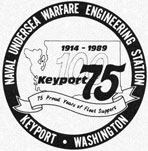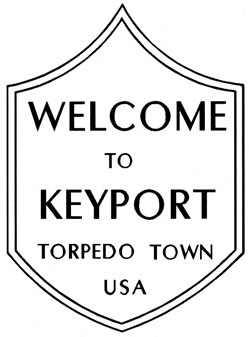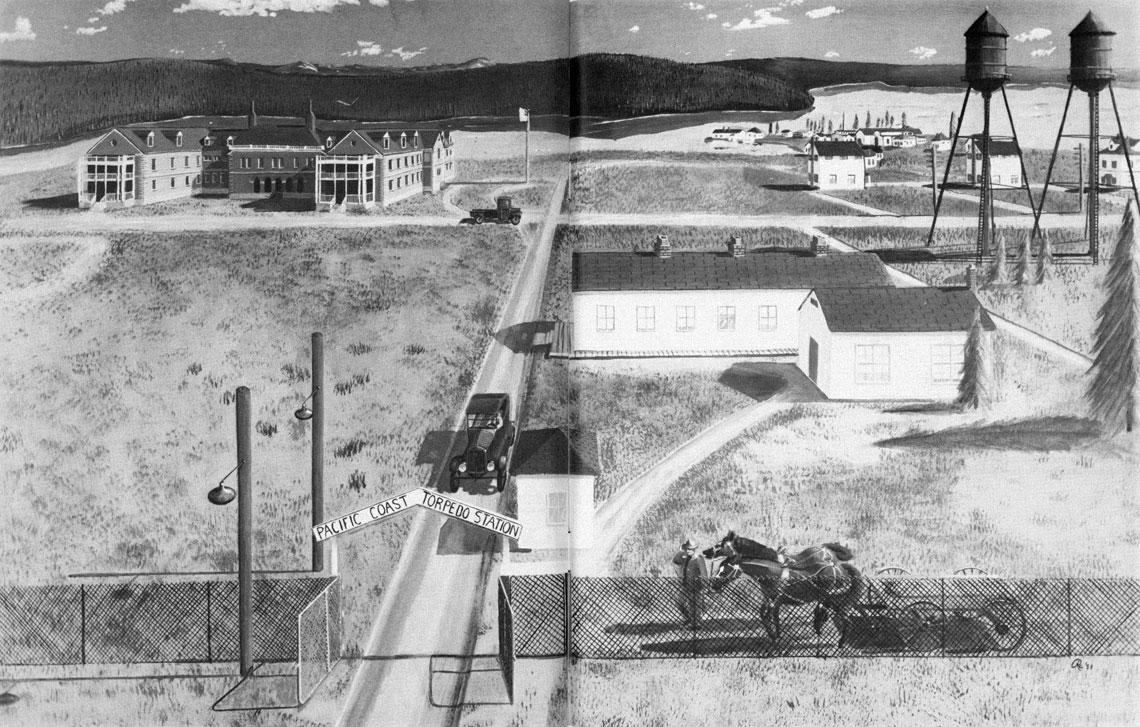(c) 1989 by Diamond Anniversary Publishing
All rights reserved. Published 1989
Printed in the United States of America
Library of Congress Catalog Number: 88-51503
ISBN 0-9621829-0-7
Diamond Anniversary Publishing
Naval Undersea Warfare Engineering Station
Keyport, WA 98345-0580
TORPEDO TOWN, U.S.A.
A History of the
Naval Undersea Warfare Engineering Station
1914-1989

Lisa Poole
with Dianne Robinson
Diamond Anniversary Publishing

On the Cover: The Giffens leave Keyport. This carriage, or U.S. Navy No. 001, was used by Robert C. Giffen to meet dignitaries during his reign as Commanding Officer, September 1929 to June 1932. He and his wife are shown as they head for a new duty station.
Inside Cover: PCTS Main Gate circa 1920. (Illustration by Rick Wall).
Inside Back Cover: NUWES Main Gate 1989. (Illustration by John Rohrer).
TABLE OF CONTENTS
| Introduction |
1 |
| Preface |
2 |
| Acknowledgements |
3 |
| Chapter One: The Key to Dogfish Bay |
4 |
| Chapter Two: From Orchards to Ordnance |
12 |
| Chapter Three: A Center of Torpedo Instruction |
26 |
| Chapter Four: A New Decade, A New Name |
40 |
| Chapter Five: Wartime's Hardtimes, the Best of Times |
46 |
| Chapter Six: From Steam to Electronics |
56 |
| Chapter Seven: Maintaining the Leading Edge |
66 |
| Chapter Eight: New Roles, New Faces, A New Name |
76 |
| Chapter Nine: The Technology Boom |
86 |
| Appendix A: Land Acquisitions, Original Purchase, Buildings, Main Gates, Torpedo Programs |
98 |
| Appendix B: Commanding Officers |
109 |

Introduction
To those who have ever found Keyport-whether to work, live or visit-and to those who are
about to find it through this book, greetings.
From a quiet farming community of Scandinavian immigrants at the turn of the century, to an
ever-important center for undersea technology, Keyport's history is vibrant, and still lives in
those who work today in support of the freedom offered by this strong nation.
I am proud of this Station's many contributions to the U.S. Navy and to the United States of
America. One and all, I hope you will find Keyport in your own way through this history book.
Robert W. Hoag, II
Captain, USN
Commanding Officer
1
Preface
The History of Keyport
History can be a difficult and time-consuming subject to pursue, especially when useful
documents and other information have been destroyed as a matter of everyday course.
That, certainly, was the dilemma facing Keyport's first official historian, Agnes Carpinella. With one
month's notice, Agnes was handed the mammoth task of making up for lost history.
The Chief of Naval Operations in 1959, seeing that much valuable information had been lost due
to the Navy's policy of destroying records after a prescribed number of years, ordered all Naval
installations to compile histories to be stored in the National Archives.
Agnes spent long afternoons at the local newspaper, scanning microfilm for tidbits of Keyport
history and, sure enough, she delivered-and on time. On October 1, 1959, one month after
being given the task, she presented the Naval Torpedo Station and the National Archives with The History of Keyport by A. Carpinella.
Though my researchers and I have done plenty of digging of our own, we certainly would not
have been able to finish this book in time for the Diamond Anniversary had it not been for the
work begun by Agnes Carpinella and those who followed her in the Station's Resources and
Planning Department.
An even greater amount of thanks goes to the research team of the Diamond Anniversary History
Book Subcommittee: Beverly Hall, Susan Huebert, Pam Perigard, and Dianne Robinson. These
individuals did an exceptional job researching Keyport's history and putting it all down on
paper.
Thanks to the above and to all who have contributed memories and photos of 75+ years at
Keyport.
What's In A Name? Keyport's Had a Few
PCTS? NTS? NUWES? Just what is the name of this Naval Station at Keyport? All three of those
acronyms (and more) have represented the Station over the years.
Most people refer to the Station as "Keyport," but in its earliest days, people were confused as
to what its precise name actually was. Some people called it Torpedo Station, Puget Sound;
others called it Keyport Torpedo Station; and still others called it Pacific Coast Torpedo
Station.
Finally, to clear matters up, Commander Henry Jenson, the first Inspector of Ordnance (Officer
in Charge), wrote to the Bureau of Ordnance asking for an official declaration of the name. The
response? "The Department has decided that the Torpedo Station, Puget Sound, Wash., shall be
known as 'Pacific Coast Torpedo Station.'"
In 1930 the poetic-sounding name was changed to U.S. Naval Torpedo Station. Most can
remember that name, as it was around for 48 years-almost. A little known fact is that when, in
1950, NTS consolidated its operation with Naval Ammunition Depot, Bangor, it took on a new
name: U.S. Naval Ordnance Depot Puget Sound. That lasted all of two years.
By 1978, it was apparent the NTS' role in the field of undersea technology was no longer limited
to torpedoes, so its name was changed to more accurately reflect its mission: Naval Undersea
Warfare Engineering Station.
So, as you're reading this book, when you see PCTS, NTS, or NUWES, you know the acronym
being used represents the era being discussed.
L.P.
Keyport, Washington
March, 1989
2
Acknowledgements
The following individuals and organizations are gratefully acknowledged for their support of
Torpedo Town, U.S.A.:
Ed Biery
Jeanne Brewer
Betty Chapman
Kitsap County Historical Society
Linda Gleason
Charlene Joslyn
Dave Pearson
NUWES' Photo Lab
Alice Peterson
Ruth Reese
Louise Reh
Lee Rutherford
North Kitsap Custom Photo Lab
Rebecca Siegrist
Joe Sommerseth
Lynn Thurmon
Rick Wall
The following are gratefully acknowledged for their financial contributions:
Black Historical Society of Kitsap County
The Jack Fletchers
Howard Garnett (VITRO)
Honeywell Engineering Services Center
Juel Lange Enterprises
Keyport Auto Repair
Keyport Mercantile
Westinghouse Electric Corporation
3
| 
